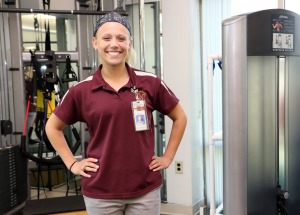
Stepping out for exercise
Do summer’s bright sunshine and warm weather call you to take your exercise out of the gym and into the great outdoors? Fresh air and sunshine are great — but not so fast! Heat and humidity, if not taken seriously, could be hazardous to your health. Bayhealth Athletic Trainer Taylor Hatfield offers some tips to exercise safely and successfully throughout the summer.
Wondering how to get started? “Every person is unique, so it’s imperative to keep in mind your fitness level, age, and any preexisting conditions when considering working out,” said Hatfield.
You should always consult a doctor before beginning a new exercise program. Undiagnosed preexisting conditions, such as asthma, diabetes, and high blood pressure, can lead to additional complications if not managed properly prior to exercise.
Don’t be aggressive when starting a new workout program. Hatfield says it can take five to seven days to become acclimated to the heat and the humidity. She suggests starting with a lighter workout such as walking, cycling, or swimming; running increases greater work for the body and also increases your body’s core temperature.
When possible, consult with a professional, such as an athletic trainer, personal trainer, exercise specialist, or physical therapist, to set up a workout routine that will help you meet your goals.
Now that you’ve made up your mind to focus on fitness, you must be prepared. Here are Hatfield’s tips on how to exercise safely:
Wear the proper attire
What you wear can help prevent heat-related injuries. Wearing loose, light-colored clothing helps deflect the sun’s heat and keeps the body cooler when exercising outside.

Be safe on the street
If you wear earbuds or headphones while walking or running, be aware of possible hazards, including traffic.
Select proper shoes
Hatfield suggests going to a shoe store to get fitted; some stores offer free computer analysis to help you select the right shoe. Cushioned inserts can also be used to reduce shock. “It’s one way to decrease injuries such as shin splints,” she said.
Avoid dehydration
When you exercise, you can lose a lot of water. Drink plenty of fluids to stay hydrated. “Replenish the body with water and electrolytes,” said Hatfield. “The intake of fluid should match the fluid lost through sweating and urination.”
Schedule your exercise around the season
During the summer, try to schedule exercise early in the morning or later in the day based on the weather. Midday exercise, when the temperature is usually the hottest, can lead to increased risk of heat-related injuries.
Plan a cooldown
As part of your exercise routine, incorporate time to cool down. “It’s important not to get overheated,” Hatfield added. Muscle cramping, profuse sweating, or vomiting suggest that the body’s core temperature is too high, which could lead to life-threatening conditions such as heat stroke or heat exhaustion.
Stretch!
Hatfield recommends dynamic, or moving, stretches before exercise. Afterwards, do static, or slow and stationary, stretches. Finally, after exercise, you should fuel your body with proper nutrition, such as protein and carbohydrates, as well as replenish your body with water and electrolytes to make up for any fluid loss.
If you’re ready to start your own fitness journey, and need support from a Bayhealth doctor, visit Bayhealth's Find a Doctor page or call 1-866-BAY-DOCS.
